The text below is an official translation of the end-of-year session of the Russian Defense Ministry’s board, with participation of President Vladimir Putin (source):
Today, the National Centre for State Defence Control has hosted an extended session of the Russian Defence Ministry Board. The session was attended by the President of the Russian Federation – Supreme Commander-in-Chief of the Armed Forces Vladimir Putin.
He assessed activity of the Armed Forces in 2018 and defined main areas for their development in future. When starting its address, Vladimir Putin stressed that the key objectives are to strengthen defensive potential, security of Russia, and reliable protection from external threats, and it is clear for all political forces and the community.
The Supreme CINC emphasized the need to adopt modern armaments which has advanced capabilities to overwhelm modern ABM systems, giving an example of manufacturing and supplying of the Avangard hypersonic missile complex.
Vladimir Putin in particularly highlighted further strengthening of combat potential of Strategic Nuclear Forces as one of the priority tasks for 2019.
The Supreme CINC pointed to the necessity to practise warfare with the use of modern arms and to train new situation in combat.
“Programmes of the exercises, long-distance voyages are to take into account non-standard situation, most modern methods and forms of warfare as well as new types of armaments and hardware”, the head of the state.
Vladimir Putin noted that nowadays literally seconds are crucial in achieving success in the battlefield, therefore it is necessary to reduce response time at all levels starting form high-ranking officers to junior commanding officers. It means we should upgrade the command and control, signal, reconnaissance and electronic warfare systems.
The Russian President also demanded to exert any effort to fully implement all social commitments to the military.
“Social guarantees: everything is done according to the plan; however, we should try to fulfill all the social guarantees of the military and their families, including such issues as nursery schools, employment, allowance, housing etc.”, instructed Vladimir Putin in his closing word at the Board Session.
Defence Minister of the Russian Federation addresses extended session of Defence Ministry Board Session
Esteemed Supreme Commander-in-Chief!
The year 2018 experienced complicating military and political situation worldwide.
The USA and NATO are augmenting its military potential.
In June 2018, the USA started to develop a new branch of armed forces – the Space Force – to gain space superiority.
The US Navy has been reactivating the Second operational fleet since this August. Its main task is to extend the American presence in the Arctic.
It was decided to establish two new commands by 2022 – the NATO’s new Atlantic Command headquarters and joint logistics command. This will enable the NATO to move troops from the USA to Europe and deploy it in the shortest possible time close to the Russian borders.
In 2019 main and reserve transport routes shall be defined.
Cross border coordination mechanisms will be determined by 2020, reducing time for obtaining the necessary authorisations from 15 to 5 days.
This year, the USA has already spent 6 bln 300 mln USD for development of the forward deployed systems, mainly in Central and Eastern Europe.
Infrastructure for new Globus-3 radar is being built 60 km from the Russian border in Norway.
This year the strength of the US marine contingent stationed in Norway has been doubled and amounted to 700 troops.
Poland gave its consent to deploy armored division of the US Army in its territory, and to allocate 2 bln USD to build infrastructure for it.
The USA plans to withdraw from the INF Treaty instead of maintaining strategic stability in the world.
The US military budget will increase form 707 up to the record 725.5 bln USD which is equal to total annual military budget of all countries worldwide.
NATO countries are about to reach 2% GDP benchmark on defence spending.
Moreover, they have doubled the number of the exercises comparing to the last year. More frequently non-members of the NATO such as Georgia, Ukraine, Sweden, and Finland are involved in the drills.
The number of reconnaissance sorties has increased for 10% in western and southwestern directions.
We are closely following the situation. Every military activity of foreign states captures our attention. We analyse its results and take into account in the combat training.
The Russian modern, mobile, compact and effective armed forces is ready to counter existing and future threats without augmenting its strength and military potential.
Pursuant to the plans approved by you, Supreme Commander-in-Chief, we improve quality of the armed forces.
The programme for manning the Russian Armed Forces with contracted servicemen is underway. By the end of 2025 their number will have reached 475,000 troops, with a corresponding decrease in conscription down to 220,000.
At the same time the armed forces are manned with professional commissioned officers. All commanders of military districts, combined arms armies, air force and air defence armies, divisions as well as 96% of commanding officers of combined arms brigades and regiments have combat experience.
Strategic Nuclear Forces are maintained at the level to guarantee nuclear deterrence.
The modernity level of the Strategic Nuclear Forces has reached 82% as it was tasked in 2017.
This year another missile regiment equipped with the Yars silo-based missile complex has taken on combat duty.
One Tu-160 and four Tu-95MS aircraft have joined the Air Strategic Nuclear Forces.
Esteemed Supreme Commander-in-Chief, as you instructed, the ballistic missile submarines (SSBN) and Tu-160 bombers underwent trials to practise firing in salvo.
This May the SSBN Yuri Dolgoruky successfully fired four Bulava ballistic missiles in salvo targeting the Kura training ground in Kamchatka. It was the first time as the SSBN of this Project fired such number of missiles in salvo.
In November the Tu-160 modernised strategic bomber launched 12 Kh-101 air-based cruising missiles at the Pemboy training ground located above the Arctic Circle.
In contrast to deployment of the US global ABM system, the Russian Armed Forces augment its strike potential.
The Kinzhal high-precision hypersonic air missile complex has entered test-combat duty. It has made 89 patrol sorties over the waters of the Black and Caspian seas.
The Peresvet laser complexes have been on test-combat duty since December 1.
Besides, the ICBM of the Sarmat strategic complex has successfully passed drop test.
In 2019 the first missile regiment equipped with strategic missile complex armed with Avangard hypersonic glide vehicle.
All these assets guarantee overwhelming of the most advanced ABM systems.
Besides, there are trials of the Borey-A-class lead submarine is underway which is featured with enhanced stealthy and reliability comparing to foreign analogues.
Regarding to the general-purpose forces.
This year, the task on increasing modernity level of the Land Forces has been exceeded by 2.3 %. This figure has reached 48.3%. The troops received 2,200 pieces of new and modern armaments.
Ten units and military bases has been formed.
Moreover 126 modern aircraft, nine spacecraft and 120 air defence weapons have been supplied to the Russian Aerospace Forces in 2018.
The share of the modern armaments in the air force has reached 64%, and 74% – in aerospace forces in general.
The Navy has been replenished with modern armaments and equipment, which level has exceeded the planned figures and reached 62.3%. Fourteen warships and 11 support vessels, four Bal and Bastion coastal missile systems.
More than 300 pieces of advanced armaments, military and special equipment as well as over 11,000 sets for parachuting personnel, weapons and cargoes have been supplied to the Russian Airborne Troops in 2018.
The share of the modern armaments in the Airborne Troops has exceeded the planned 63.7%.
Middle-range unmanned aerial vehicles are being developed. Next year they will enter the service with the troops.
Under the State Defence Order the troops annually receive over 300 short-range unmanned aerial vehicles. Its number in the Russian Armed Forces has exceeded 2,100.
Automated command and control system of the Armed Forces is being upgraded as the top priority task.
In order to ensured balance development of all its components, we implement the Complex Targeted Programme. It enabled to create all elements of the advanced automated C2 system on the basis of the domestic hardware and software platform.
More than 31,000 pieces of signal equipment have been supplied to the Armed Forces this year, which increased the share of modern equipment in C2 system up to 66%.
In general, all the events provided by the Defence Ministry Action Plan and 2018 Stated Defence Order have been successfully implemented. In some items of armaments such as aircraft we are reaching targeted figures. Therefore, the diversification missions assigned by you are becoming more topical. They will enable the industrial defence enterprises to issue highly-demanded high-tech civil products.
In many ways, the efficiency of state defence order was facilitated by the joint information network established upon your order. Within this system this year we have developed and introduced separate record-keeping of financial and economic operations.
It can record and process reports of the enterprises implementing the State Defence Order separately on state orders and other economic operations.
These measures will enable us to monitor pricing of products supplied under the State Defence Order.
The Armed Forces being provided with new and modernized armaments on a regular basis learn to operate new equipment and conduct intensified combat training.
There were six surprise readiness complex checks involving all military districts, service arms and branches of the Armed Forces.
Vostok 2018 manoeuvres were the biggest exercises within the combat training in the contemporary history of the Russian Federation.
They were held in an international format involving military units of the People’s Liberation Army of China and Mongolian Armed Forces.
One can compare these drills with the Zapad 1981 manoeuvres in strength of troops and armaments involved. However, the Vostok 2018 manoeuvres are biggest in its scale and redeployment extent in contrast with drills held in the USSR.
In 2018 the Navy held a large-scale in eastern part of the Mediterranean Sea.
A detachment made up of 28 warship and vessels as well as 36 aircraft of the Naval air force proved its efficiency to fulfil assigned missions defending national interests of the Russian Federation in the Mediterranean Sea.
The level of field, air, and naval training skills has improved. Over the past year, the Russian Armed Forces carried out over 18,000 exercises and training at various levels.
Joint trainings have intensified for 16%, and bilateral trainings – for 20%.
Every year foreign countries get more interested in the International Army Games, which have become an integrated component of the combat training. The Games’ contests took place in seven countries – Russia, Azerbaijan, Belarus, China and Kazakhstan. Armenia and Iran hosted some contests for the first time.
The Games were attended by 189 teams made up of 4,700 servicemen from 32 countries.
Along with the ARMY International Military and Technical Forum, the Games are also considered to be great platform for demonstration of capabilities and advantages of the domestic armaments over foreign analogues. They significantly contribute to export portfolio of the Russian military hardware.
Esteemed Supreme Commander-in-Chief!
Last December the Russian Armed Forces completed an operation in the Syrian Arab Republic. A total of 96% of its territory was liberated from terrorist organisations.
The operation’s results were reported in detail at a special session on it.
Pursuant your instruction, we have completed withdrawing main forces from Syria. Equipment and armaments were redeployed back to the Russian Federation excluding that hardware in service with our bases in Hmeymim and Tartous.
The force grouping was reduced and reached the standard staff strength which is enough for the assigned missions. Their composition is standard, and strength is comparable to our military bases stationed in Kyrgyzstan, Tajikistan and Armenia. Besides, military advisers, special forces, the Centre for Reconciliation of Opposing Sides and military police are operating in Syria as well.
Ari forces make up to 2-4sorties a week, mainly for reconnaissance purpose.
The main achievement reached in spring and summer 2018 is that the Syrian government regained control over Damascus outskirts practically without resorting to force: Eastern Ghouta, Eastern Qalamoun, and Yarmouk; northern regions of Homs province as well as al-Suweyda, Daraa and al-Quneitra provinces.
This was facilitated by active work of the Russian Centre for Reconciliation of Opposing Sides with opposition field commanders and Syrian government.
Amid stabilization of situation in Syria there is a large-scale recovery programme underway to restore peaceful life and ensure repatriation of refugees.
Joint coordination centres have been established in Russia, Syria, Lebanon and Jordan to coordinate these missions. Together with authorized international organisations they work on repatriation of refugees and providing them with all necessities.
Since July 2018, in total 68,230 people have already returned back to Syria.
Since 2015 more than 1.5 mln refugees and internally displaced persons have returned back to their former homes.
The Russian Centre for Reconciliation of Opposing Sides this year has ensured delivery of 86 humanitarian convoys sent by the UN and other international organisations. In total there were 294 humanitarian actions; 37,000 people were provided with medical assistance. Besides, 163,215 civilians got food supplies.
A political dialogue is the most important step in settling the conflict. It was boosted by negotiations in Astana format. The Congress of the Syrian National Dialogue was successfully held in Sochi paving the way to formation of the Constitutional Committee.
Thus, new political environment is being created to preserve state integrity of the Syrian Arab Republic.
Combat experience acquired in Syrian is widely taken into account and introduced into educational process.
All military education institutions have adopted electronic storage media – 12,000 educational e-books.
Adopting modern teaching methods significantly increase general level of cadet training.
Over the past five year they have shown great results in international academic competitions.
The Geographic Dictation expands the vision. Over 150,000 people form the Russian Armed Forces participated in it. This year we also launched the Military Historical Dictation. It was attended by 50,000 servicemen.
This year we have completed the military educational system which ensured a fully-fledged graduation from universities of the Russian Defence Ministry. Over 12,000 commissioned officers were sent to the troops. All the graduates were appointed to the posts in accordance with their speciality, guided by experienced mentors.
Military education becomes more popular among the youth. It was the first time as this year the number of candidates competing for each place reached up to eight people, and in some institutions – up to 20 people per place.
Students from 81 countries are studying at universities of the Russian Defence Ministry which exceeds figures of the USSR.
According to your instruction, 60,000 students undergo military training course in 93 military training centres as part of their studying.
We actively develop training facilities of pre-higher educational institutions. The Nakhimov Naval School has introduced a multifunctional building equipped with modern laboratory items.
In total since 2013 we have established 15 pre-higher educational institutions, with four Suvorov Military Schools, three Presidential Cadet Schools, three branches of the Nakhmov Naval School, two cadet corps, and three schools for gifted children.
The first-ever Open Cadet Games were successfully organized. Next year they will be held on international scale.
Scientific units (companies) is a reliable source for enhancing military scientific potential of the Russian Armed Forces. Since they were created, 459 servicemen have become commissioned officers. In total 1,285 projects have been put into operation, 110 inventions have been registered.
The ERA innovative technopolis of the Russian Defence Ministry was established for research and development work. It includes 18 laboratories equipped with 600 pieces of unique outfit. Representatives of 32 leading industrial enterprises, scientific organizations and operators of four newly-formed scientific units are involved in R&D works at the technopolis.
This project will promote development of fundamental and applied science, as well as hi-tech manufacturing.
Innovative approaches are fulfilled in the Effective Army programme. Over the five years we have managed to close the gap in basic indicators of combat service support and community services amid increasing prices on these services. At the same time in the framework of these measures the Russian Defence Ministry does not ask any extra finances to augment the military budget. Notional savings would have amounted to 340 bln roubles.
Recovered repair units produce some 1 bln of budgetary savings a year.
Besides, 730 control systems installed in the canteens of military units have saved some 3 bln roubles.
As all military settlements were equipped with 111,030 utility metering devices it has saved 5 bln 300 mln roubles.
At present the NOVATEK company develops a pilot project to convert two boiler houses in Murmansk region to use liquefied natural gas. Following the results of the project we will make a programme to convert all such boiler facilities using diesel and marine diesel fuel.
The estimated cost advantage of one such boiler house will amount to 10-12 mln roubles a year.
Workshops re-established at armouries this year have repaired 550,000 missiles and pieces of ammo. The procurement would have costed 63 bln roubles.
Since 2016 some new 590 pieces of corking material have been procured and supplied to armouries. It ecomomised 1 bln 400 mln roubles.
As an automated personal data system for servicemen using the Pasport electronic cards will have been put into operation by 2020, it will save up to 1.5 bln roubles.
The Russian Defence Ministry is transferring ownership of some assets to territorial entities of the Russian Federation in order to cut expenses on preserving properties unused by Russian Armed Forces. Since 2013 we have transferred 3,210 houses, 8,144 facilities of public utilities, 1,482 social and 16,565 and industrial-purpose facilities.
The total cost advantage makes up 9 bln 300 mln roubles.
We have boosted construction works to build special facilities, dwellings and infrastructure by change the whole military construction system.
Through it we also managed to synchronize deadlines for building infrastructure and supplying armaments and military hardware to the troops.
This year in total 3,573 building and facilities (600 thous. sq m) have been constructed, reconstructed and overhauled. Comparing to the previous year, the completion rate of construction works has been increased for 6 % with the same funding level.
This is reached by using of standard and modern technological projects. As a result, a square-meter cost of construction of the Russian Defence Ministry’s facilities does no exceed 32,000 roubles which is lower than the average throughout the country.
Reconstruction of airfield system is nearing its completion. Nineteen airfield have already been fitted with 3,000,700 sq m of paved movement area.
We complete outfitting of missile brigade armed with Iskander-M missile complex. In 2013-2018 in total 458 facilities have been built for ten missile brigade.
All the Iskander-M systems supplied to the troops are kept in standard conditions and are ready for operation.
In order to improve and optimize storing of armaments, missile and ammunition, 366 armouries out of 580 have been built, with 221 of them – this year. This will enable to store 218,000 tons of ammunition. The rest of armouries will be built in 2019.
Infrastructure is being constructed for the Yars mobile and silo-based missile complexes supplied to the Strategic Missile Forces. Missile launch positions have been put into operation in six missile regiments; there are combat duty points arranged at points of temporary deployment in seven regiments.
The first pilot Nara manufacturing logistics complex has started functioning this year. It now houses 2,000 pieces of equipment and some 18,000 tons of material assets. Therefore, we were able to eliminate four out of 27 unpromising and outdated bases and storages.
Next year it is planned to launch construction of another two manufacturing logistics complex in Sevastopol and Arkhangelsk financed by private investments under concession contracts.
Oil companies have commissioned 12 bulk fuel installations at the airfield of the Russian Defence Ministry, another three are about to be constructed.
PJSC Rosneft and PJSC Lukoil have joined this project. In 2019 they will launch building of 12 complexes.
The total level of investments made by oil companies has already amounted to some 17 bln roubles.
Twenty premises have been erected at the Severomorsk-1 airfield to resume flights. Its runway was reconstructed and equipped with modern radio-technical and illumination flight facilities.
Fifty-nine buildings and structures at military settlement for a radar section and air direction center are about to be constructed on Alexandra Land Island.
The Temp airfield at Kotelny Island is being reconstructed. A modular settlement is being built in Tiski to accommodate 3rd Air Defence Division of the Northern Fleet to be formed in 2019.
The Russian Armed Forces complete operation to remedy ecological damage to the Arctic where troops were stationed.
In total the ecological units have cleared 104,000 sq km of the territory since 2015. They collected 18,572 tons and took out 16,000 tons of scrap metal.
There are 9,000 sq km left to be cleared which is nearly 9% of the territory.
As you instructed at the extended session of the Russian Defence Ministry last year, we worked jointly with authorities of the Russian entities to address social issues of the military and their families. It resulted in decrease of queues to pre-school organizations by 97% and decrease of the number of unemployed families of servicemen by 99%.
These issues have been fully implemented in 80 entities of the Russian Federation.
In the republics of Dagestan, Northern Ossetia-Alania and Sakhalin region there are 202 children left without places in nursery schools.
At the same time, the Russian Defence Ministry has fully implemented the decision of the Russian government to put 467 nursery schools under management of local authorities.
At the same time, the plan on providing the military with permanent home was accomplished. Over the past year we provided 8,300 servicemen with permanent home with 2,800 of them receiving apartments, and 5,500 people – housing allowance.
We have intensified work by 5.5 times to form a specialized housing stock. This enable us to bring its level up to 78,000 corporate apartments. In 2018 this housing stock has received 16,500 apartments, with 35,500 military families provided with corporate apartments.
The savings and mortgage system is being developed. This year another 43,000 servicemen have joined the system. It is two times more than in past years. At the same over 64% of participants are privates and sergeants on contracted service.
Esteemed Supreme Commander-in-Chief, by implementation of your decision to index allowance of the military, its amounted is maintained at a wage level in leading economic sectors.
As part of implementation of May decrees it is provided for annual indexation of pensions and allowance.
We have created a network of modern military medicine. We have reached a full range of high-tech medical care at the level of international standards. We have finished transferring 29 hospitals and clinics to the Ministry of Health and the subjects of the Russian Federation.
The appearance of medical institutions has changed. They are equipped with modern facilities. Telemedicine consultations and sanitary and aviation evacuation systems are deployed and are functioning.
As a result, over three years, the level of illnesses of military personnel has decreased by 16% and for the most topical pathology, such as respiratory diseases by 23%.
More than 15,000patients received high-tech medical care this year.
187 emergency and planned telemedicine consultations were conducted for the military personnel of the remote garrisons.
Since the beginning of the use of multifunctional medical aviation modules, more than a 1,300 people have been saved.
In accordance with your decree, this year we have begun the creation of military-political bodies.
New approaches of work with military personnel, initiated by the leadership of the Armed Forces, are based on sociological research conducted by the troops in 2013–2017.
One of the most important areas of military-political work is the patriotic education of servicemen of the Armed Forces and youth.
The Yunarmiya All-Russian Children-and-Youth Military-Patriotic Public Movement is expanding every year. Today it is represented in each subject of the Russian Federation and unites 276,125 teenagers.
In summer, 1,637 camps and 26 expeditions were conducted, which is 15 times higher than last year, and the number of participants was 83,000 children and adolescents.
Following the example of houses of pioneers and child arts centres, houses of Yunarmiya and Patriot parks are creating in garrisons, which will provide an opportunity for children to engage in special study groups and clubs year-round.
The Army 2018 International Military and Technical Forum and the Week of National Security International Forum have become an effective form of establishing interaction between the authorities and the business community and the development of international military-technical cooperation.
Representatives of 118 countries of the world took part in their work, including 102 official military delegations, which is two times more than last year.
This indicates the growth of their popularity and international recognition.
Military cooperation activities this year covered 98 countries. In the sphere of military-technical cooperation, China, India, Egypt, Algeria and Vietnam remained priority partners for us. Increased military contacts within ASEAN. We are actively participating in the SMOA-plus dialogue.
They continued to strengthen allied relations with the CSTO, the CIS and the SCO. 25 international exercises of various levels were conducted. The most ambitious of them were the CSTO Interaction 2018 exercise and the SCO Peace Mission 2018 maneuvers.
This year the Moscow International Conference on International Security was attended by a record number of delegates: more than 850 representatives from 95 countries and eight international organizations.
Esteemed Supreme Commander-in-Chief!
The Armed Forces have fulfilled all the tasks assigned for 2018.
We have improved combat capabilities by 11% and ensured a given level of maintaining the country’s defence.
There is a qualitative and quantitative growth of the main indicators in comparison with 2017.
In general, the share of modern armaments in the armed forces has reached 61.5%.
In 2019, the Ministry of Defence is faced with a number of priorities.
- Strategic Nuclear Forces.
- To put 31 Yars and Avangard launchers with intercontinental ballistic missiles into combat duty of the Strategic Missile Forces.
- To strengthen the Strategic Nuclear Forces with four modernized Tu-95ms strategic missile carriers.
- To supply the fleet with the, Borey-A-class lead nuclear submarine cruiser Knyaz Vladimir, armed with the Bulava ballistic missiles.
- General-Purpose Forces.
- Eleven formations and units were formed to improve the district and army staff of the Land Forces.
- To supply the Land Forces, coastal forces of the Navy and the Airborne Troops with 719 modern armored vehicles, one brigade complex of the Iskander-M missile system, two brigade complexes of the S-300V4 and Buk-M3 missile systems. To bring the share of modern samples up to 50.8%.
- To supply the Aerospace Forces, naval air force and air defence troops of the Navy with 143 new and upgraded aircraft, two regimental complexes of the S-400 Triumph anti-aircraft missile system, one Vityaz anti-aircraft missile system and seven divisional complexes of the Pantsir anti-aircraft missile system.
- To bring the part of modern samples in the Air Forces up to 65%, as well as up to 81.8% in the Aerospace Forces. To ensure the fulfillment of the tasks of the experienced combat duty of the Unified Space System.
- To supply the Russian Navy with 12 ships and combat boats, two submarines, 12 support vessels. To supply troops with four coastal missile systems Bal and Bastion. No bring the part of modern samples in the Navy up to 64%.
- As a result, to ensure timely deployment and rigorous execution of the tasks of State Defence Order 2019 and bring the share of modern armaments of the Armed Forces up to 67%.
- To prepare and conduct 18,500 different exercises and trainings including Tsentr 2019 strategic exercise and Grom strategic nuclear exercise.
- To put into operation 3,751 buildings and structures simultaneously with supplying weapons and military equipment to the troops.
- To complete environmental work in the Arctic, clean up the remaining 9,000 square kilometers.
- To build the Presidential Cadet School in Kemerovo and the Military Girls School of the Ministry of Defence in St. Petersburg.
- To intensify the military-patriotic work among young people. To increase the number of Yunarmiya members up to 500,000 teenagers.
- In the next three years, to build ice skating rinks, swimming pools and sports camps in all pre-university institutions of the Ministry of Defence.
- Continue the implementation of the Effective Army program.
- By 2020, to complete the implementation of a system for recording personal data of military personnel using electronic cards.
- Esteemed Supreme Commander-in-Chief!
Ways of solving the problematic issues identified during the work were taken into account in the plans of the Ministry of Defence for 2019-2025.
We will discuss them in more detail during the closed part of the Board Session.
Thank you for your attention.



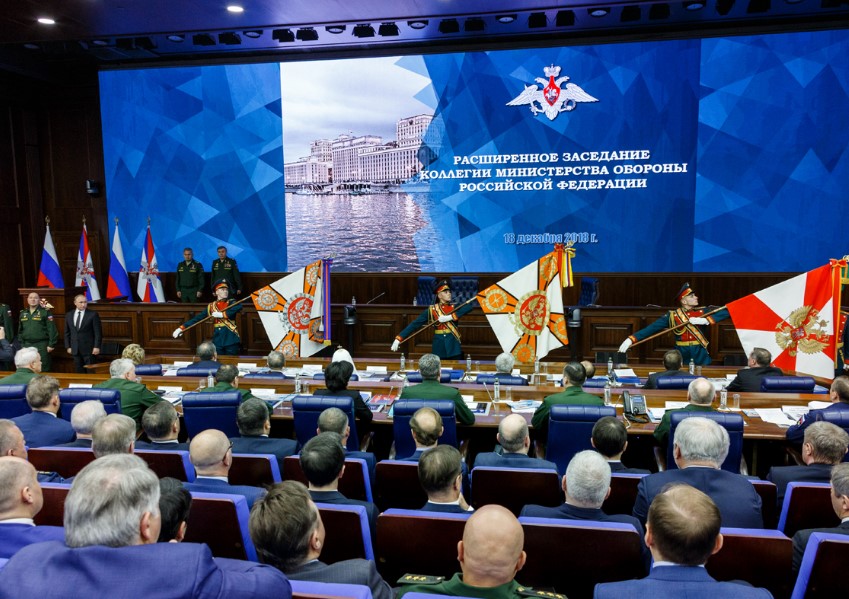
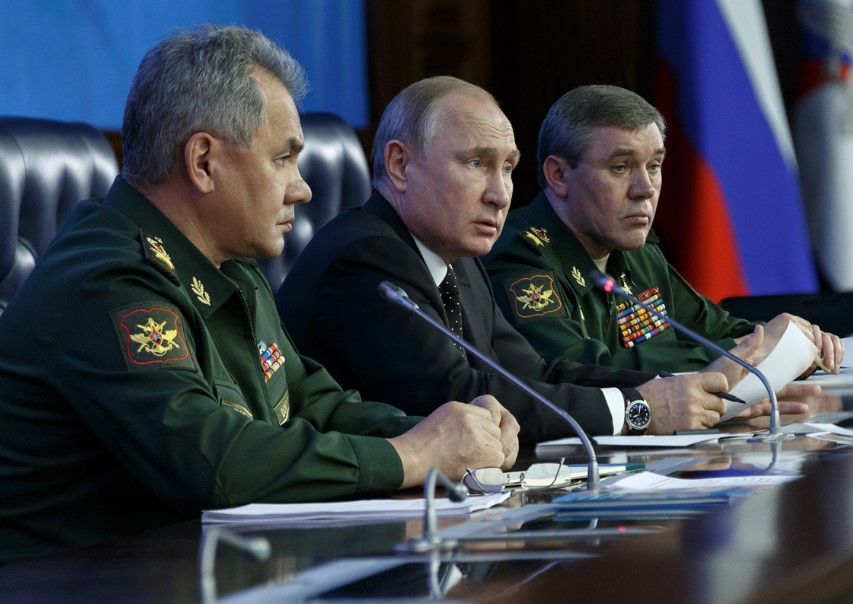
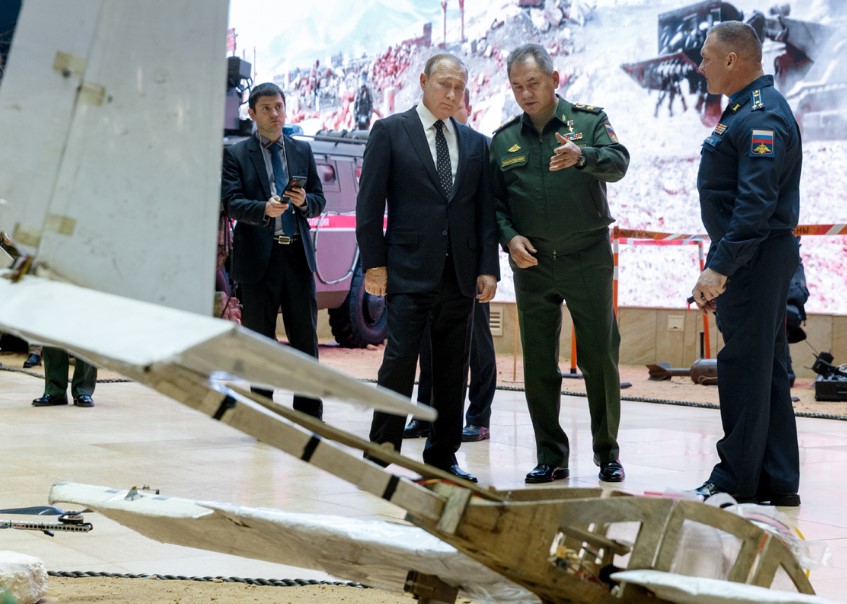
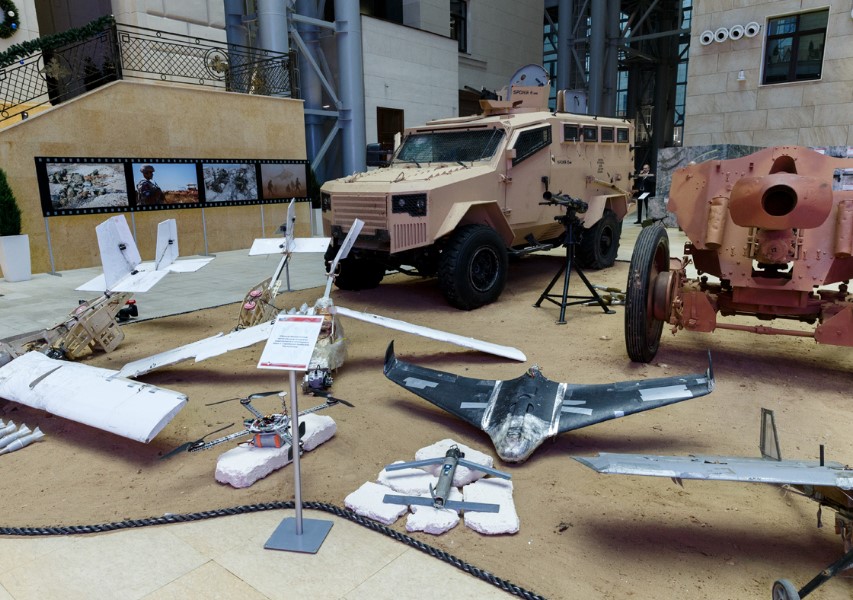
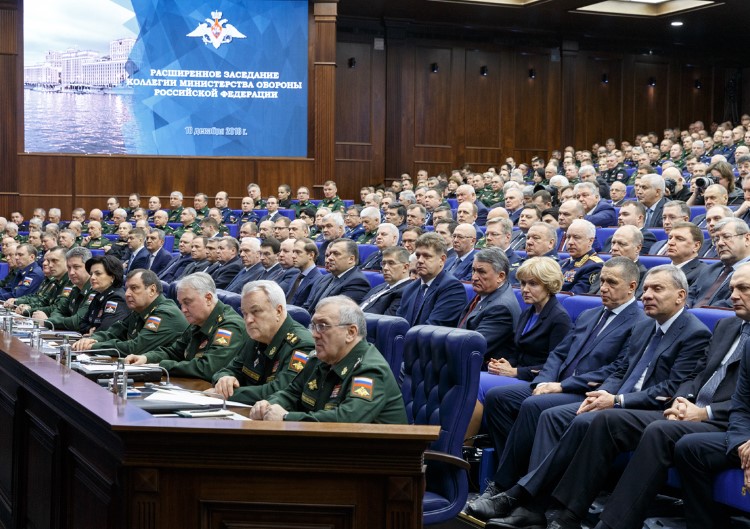



Talk about doing more for less. No room for transgender toilets.